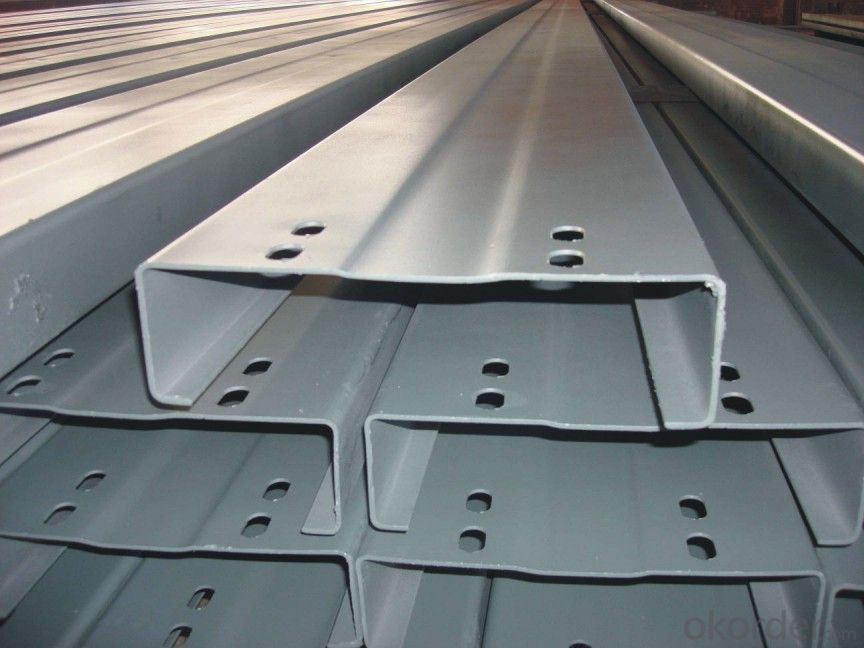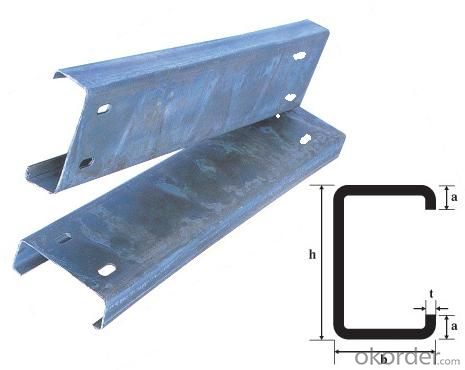C Steel Profile C Channel Manufacturer ,OEM Supplier,UL,NEMA Tested
- Loading Port:
- Tianjin
- Payment Terms:
- TT or LC
- Min Order Qty:
- 25 m.t.
- Supply Capability:
- 24000 m.t./month
OKorder Service Pledge
OKorder Financial Service
You Might Also Like
Product Description of C Steel Profile C Channel Manufacturer ,OEM Supplier,UL,NEMA Tested
C Steel Profile C Channel Manufacturer ,OEM Supplier,UL,NEMA Tested is a standardized formed structural system used in the construction and electrical industries for light structural support, often for supporting wiring, plumbing, or mechanical components such as air conditioning or ventilation systems.
Performance of C Steel Profile C Channel Manufacturer ,OEM Supplier,UL,NEMA Tested:
1.Convenient in construction and save much time and labor.
2.Light and cheap.
3.High mechanical strength.
4.Various kinds of fittings can make up of many combinations also for safety
5.Attractive in appearance.
6.Samples are free
strut channel :slotted or plai
C Channel
Solid channel has no holes predrilled, and must either be drilled on site or mounted in another fashion. Punched channel has round holes, large enough for 5/8 inch threaded steel rod or bolts, punched in the top of the channel at regular 1 7/8 inch centers. Half-slot channel has short, rounded end rectangular slots punched out on 2 inch centers. Slot channel has longer slots on 4 inch centers.
Standard: 41mmx41mm, 41mmX21mm, 41mmx61mm, 41mmX81mm
Wall thickness: 1.5mm, 1.6mm, 2.0mm, 2.5mm, 2.7mm (can produce based on your requirement).
Length:3m (can produce as your requirement)
Holes:28*14mm,18*9mm,13.5*63mm,11*25mm,11*30mm etc
Strut Channel Material :
Carbon steel or SS304 or SS316
Strut Channel Finishes :
Plain, Galvanized, Hot Dipped Galvanized, Polyester Powder Coated (other finishes available on request)
Parts of Our Products



- Q:What are the different shapes of steel channels available?
- There are several different shapes of steel channels available in the market. Some of the common shapes include: 1. C-Channel: This is the most commonly used shape of steel channel, which resembles the letter "C". It has a flat base and two perpendicular sides. C-channels are versatile and widely used in construction and structural applications. 2. U-Channel: U-channels are similar to C-channels but have a slightly different shape, resembling the letter "U". They have a flat base and two perpendicular sides, but the sides are typically shorter than C-channels. U-channels are commonly used for edging, framing, and support purposes. 3. Hat Channel: Hat channels, also known as furring channels or resilient channels, have a unique "hat-like" shape, with a flat base and two parallel sides that taper towards the top. These channels are primarily used as a support system for attaching gypsum boards or other wall materials. 4. Box Channel: Box channels, also known as rectangular channels, have a square or rectangular shape. They have four equal sides and are often used for structural applications where strength and rigidity are required. 5. Z-Channel: Z-channels have a distinctive "Z" shape, with two parallel sides that are connected by a vertical middle section. These channels are commonly used in construction for framing, bracing, and supporting applications. 6. Lipped Channel: Lipped channels, also known as lip channels or lip sections, have an additional lip or flange on one side. This lip provides extra strength and rigidity, making lipped channels suitable for heavy-duty applications such as structural support and framing. These are just a few examples of the different shapes of steel channels available. The choice of shape depends on the specific application and the required strength and functionality of the channel.
- Q:How do steel channels contribute to building aesthetics?
- Steel channels contribute to building aesthetics in several ways. First and foremost, steel channels are often used as structural elements in buildings, providing strength and stability to the overall structure. However, they also play a significant role in enhancing the visual appeal of a building. One of the key ways steel channels contribute to building aesthetics is through their sleek and modern appearance. Steel channels have clean lines and a smooth surface, which can give a building a contemporary and sophisticated look. They can be used in various architectural designs, ranging from industrial to minimalist, adding a touch of elegance and sophistication to the overall aesthetic. Additionally, steel channels offer versatility in terms of design possibilities. They can be easily customized and fabricated into different shapes and sizes, allowing architects and designers to create unique and visually striking elements. Steel channels can be used as decorative features, such as handrails, balustrades, or window frames, adding visual interest and architectural detailing to the building. Moreover, steel channels can be finished with different coatings or treatments to further enhance their aesthetic appeal. They can be painted in various colors to match the overall design scheme or can be left exposed, showcasing the natural beauty of steel. Additionally, they can be polished or brushed to achieve different textures and finishes, adding depth and character to the building's appearance. Furthermore, steel channels can contribute to the aesthetics of a building by creating a sense of openness and transparency. When used as structural elements in facades, they can support large glass panels, allowing for expansive views and natural light to enter the building. This creates a visually pleasing and inviting atmosphere, connecting the interior spaces with the surrounding environment. In conclusion, steel channels contribute to building aesthetics by providing a sleek and modern appearance, offering design versatility, facilitating customization, and creating a sense of openness. With their clean lines, smooth surface, and various finishing options, steel channels can enhance the visual appeal of a building, adding elegance, sophistication, and architectural detailing to the overall design.
- Q:Can steel channels be used for marine applications?
- Steel channels are indeed suitable for marine applications. They serve as versatile structural components widely utilized in shipbuilding and other marine-related industries. With their exceptional strength and durability, they prove to be ideal for various marine uses, including ship hulls, decks, bulkheads, and frames. By applying suitable coatings and treatments, the corrosion resistance of steel channels can be enhanced, allowing them to withstand the harsh marine environments. Moreover, steel channels can be effortlessly fabricated and welded to meet specific design specifications, making them the preferred option in marine construction.
- Q:No. 8 at No. 6 steel, how much is the channel size
- The dimensions are eighty cm and sixty cm
- Q:Are steel channels suitable for the agricultural industry?
- Steel channels are well-suited for the agricultural sector. Their versatility and durability make them an excellent choice for a wide range of agricultural applications. These channels can be utilized in the construction of barns, sheds, and fencing, providing a sturdy and durable framework. Furthermore, their resistance to corrosion is essential for enduring the harsh outdoor conditions commonly found in agriculture. Additionally, they can bear heavy loads and offer stability, making them suitable for equipment like grain bins and livestock handling systems. Moreover, steel channels can be easily customized and fabricated to meet specific requirements, allowing for flexibility in design and construction. Overall, steel channels provide the necessary strength, durability, and versatility required in the agricultural industry.
- Q:What are the different welding methods for steel channels?
- Different welding methods can be used for steel channels depending on the application and desired outcomes. Some common methods for steel channels include: 1. Stick welding, also known as Shielded Metal Arc Welding (SMAW), involves creating an arc between an electrode coated in flux and the base metal. It is versatile and suitable for both thick and thin steel channels. 2. Gas Metal Arc Welding (GMAW), commonly referred to as MIG welding, uses a continuous wire electrode fed through a welding gun. The wire is melted and joined with the base metal while being shielded by a gas mixture. It is known for its speed and efficiency, making it ideal for high-volume production. 3. Flux-Cored Arc Welding (FCAW) is similar to GMAW but uses a flux-filled tubular wire instead of a shielding gas. The flux creates a protective shield around the weld and is useful for outdoor applications or environments with strong drafts. 4. Gas Tungsten Arc Welding (GTAW), also known as TIG welding, uses a non-consumable tungsten electrode to heat the base metal. A separate filler rod is manually fed into the weld pool, providing precision and control for thin steel channels or high-quality welds. 5. Submerged Arc Welding (SAW) involves feeding a continuous wire electrode into the joint while a layer of granular flux covers the weld zone. The arc is submerged beneath the flux, providing protection. This method is commonly used for thicker steel channels or high deposition rates. When selecting a welding method, it is important to consider the specific requirements of the steel channel and the intended application. Each method has its own advantages and limitations, so choosing the most appropriate method is crucial for achieving desired results in terms of strength, aesthetics, and efficiency.
- Q:Are steel channels prone to rusting?
- Yes, steel channels are prone to rusting. Steel is primarily made of iron, and when exposed to moisture or oxygen, it can undergo a chemical reaction known as oxidation, which leads to the formation of rust. Rusting weakens the steel structure, making it more susceptible to corrosion and eventual failure. Therefore, steel channels need to be protected from moisture and other corrosive elements using appropriate coatings or treatments to prevent rust formation and prolong their lifespan.
- Q:8 channel steel and 40*60 square steel tube, which is good in bending strength?
- Channel moment of inertia Ix=101, Iy=16.6
- Q:How can channel A and B be distinguished?
- Grade a do not do impact test, B do, B quality is better than A, general bad steel above will have labels
- Q:How do steel channels contribute to the overall safety of a structure?
- Steel channels contribute to the overall safety of a structure by providing structural support and stability. They are used to reinforce beams, columns, and frameworks, enhancing the load-bearing capacity of the structure. Additionally, steel channels can help distribute and redirect forces, such as those caused by wind or seismic activity, reducing the risk of structural failure. Their high strength and durability make them resistant to deformation and ensure long-term stability, further enhancing the safety of the entire structure.
1. Manufacturer Overview |
|
|---|---|
| Location | |
| Year Established | |
| Annual Output Value | |
| Main Markets | |
| Company Certifications | |
2. Manufacturer Certificates |
|
|---|---|
| a) Certification Name | |
| Range | |
| Reference | |
| Validity Period | |
3. Manufacturer Capability |
|
|---|---|
| a)Trade Capacity | |
| Nearest Port | |
| Export Percentage | |
| No.of Employees in Trade Department | |
| Language Spoken: | |
| b)Factory Information | |
| Factory Size: | |
| No. of Production Lines | |
| Contract Manufacturing | |
| Product Price Range | |
Send your message to us
C Steel Profile C Channel Manufacturer ,OEM Supplier,UL,NEMA Tested
- Loading Port:
- Tianjin
- Payment Terms:
- TT or LC
- Min Order Qty:
- 25 m.t.
- Supply Capability:
- 24000 m.t./month
OKorder Service Pledge
OKorder Financial Service
Similar products
New products
Hot products
Related keywords





























